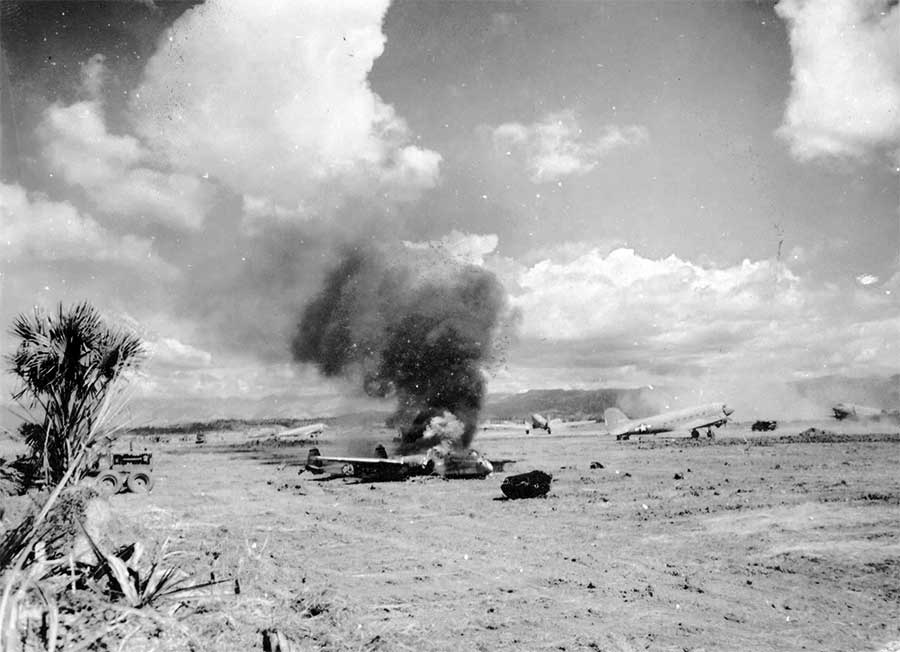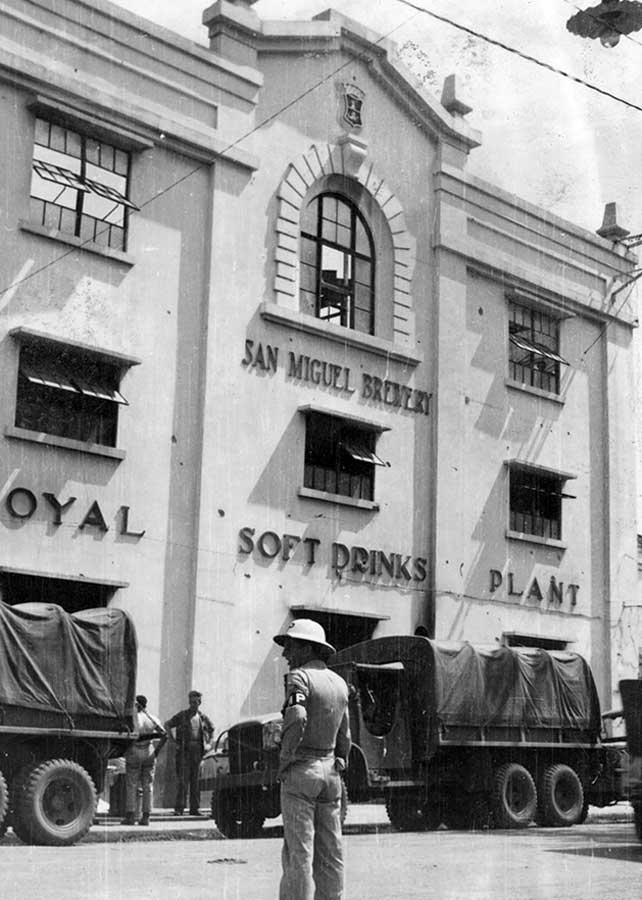Following is an undated memo found among Pfc Eve’s collection entitled “Combat History of Mobile Photo Lab.” It details the Mobile Photo Lab’s creation in September 1944, as a resource for the Philippine invasion, and ends with its “retirement” in March 1945, when the unit set up permanent facilities in Manila.
Although it’s long and sometimes jargon-filled, I thought it important to preserve Captain Herman’s voice. My comments appear in brackets. I’ve also annotated the memo with photos from Pfc Eve’s collection and with relevant Internet links and videos.
I’ve recently traced two men mentioned here: Pfc Ovid di Fiore and S/Sgt Charles Restifo.
From: Capt. Herman
To: Lt. Sontheimer
In preparation for U.S. invasion of the Philippines, the Chief Signal Officer, General Akin, approved construction of a specially designed mobile photographic laboratory late in September, 1944. The mission of the mobile unit was to provide immediate photographic processing of high priority pictures for the general staff sections moving forward with the advance echelon of GHQ.
Built into the van of a 34-ft, semi-trailer vehicle, the laboratory was completely planned for field operation. Included were negative developing room, printing room with enlargers and contract printers, temprite cooling unit for temperature control of developing solution, small, drum-type dryer and built in tank converted from airplane belly tank, and two PE-75 generators for electric power.
With 1st Lt. Harold C. Herman as the officer in charge, the crew consisted of the following: Sgt. Ralph Glanz, lab supervisor, Pfc Ovid Di Fiore, clerk, Pvt John Condra, negative developer, Pfc Thomas Kearns and Pvt Cecil Johnson, print room technicians; Pvt Benny Maendl, utilities maintenance and relief driver and Pfc Paul Perry, driver.
Leaving Hollandia, Netherlands East Indies [Dutch New Guinea], with the advance echelon of GHQ, 16 October 1944, the mobile laboratory moved in convoy to Leyte Island, Philippines, landing “D” plus 2 on White Beach, at Tacloban.
Sleeping under the laboratory truck and other vehicles during their first night on the beach-head, the crew members got their first taste of combat. Sniper fire crackled close around them and U.S. artillery barrages screamed overhead intermittently
Burning P-38, knocked down over Leyte, PI, Dec 1944.

Less than twenty-four hours later the laboratory had been set up at the Tacloban Ice and Electric Plant, where well water was available, and the unit was ready for operation. During the first days after the invasion, and before the air-strip was built so that land fighters could come in, mobile laboratory personnel learned firsthand about the difficulties of operating under aerial attack. Despite frequent stolen glimpses outside to watch zeros hurtling earth-ward in flames during dog-fights with Navy fighters, the men turned out the required volume of production needed by all GHQ sections.
To handle priority, tactical processing at night, the men often worked through Jap air-raids in which bombs struck within a block on all four sides of them. Exploding bombs frequently caused so much vibration of photo enlargers that prints blurred and had to be remade. Yet, production kept up to schedule and the men slept when they could.
Throughout the first month on Leyte Island, the mobile lab crew worked an average of 12 to 18 hours a day (and night). The “on-the-spot” processing service which General Akin had planned, was provided for G-2, signal operations and construction sections, press relations and the C-in-C.
Work was also done for outside organizations whose laboratories had been sunk enroute or bombed out on the beach-head. These included the Fifth Air-Force, Units of the U.S. Navy, USAFFE, Sixth Army and the Philippines Commonwealth Government.
For greater efficiency, laboratory personnel set up mess and quarters adjoining the processing plant. Increasing demands for reproducing tactical photographs, maps, charts, circuit diagrams, plans for signal installations for future operations sent production up to 2-1/2 times the volume for which the mobile unit had been originally designed.
General Akin’s words, “The mobile laboratory has fulfilled its mission excellently,” came as reward for the crew’s technical skill and devotion to duty.
As the only photographic unit in full operation on Leyte Island, the mobile unit was called on to reproduce a large share of the situation maps and signal installation charts in preparation for the invasion of Luzon. The engineer reproduction plant, which normally did much of this type of work, had been blown up at sea. The Fifty Air Force laboratory had also been bombed out and destroyed on the beach-head.
Just before orders came to move forward, there were several changes in personnel. T/4 John Quinta replaced Di Fiore as clerk, Pvt George Janisch replaced Pvt Perry as mechanic and driver and Pvts Glenn Eve and Hubbitt Quon together with Stanley Lambert were added to the crew. On January 20 the lab sailed on an LST to Luzon (see video below).
On Luzon
Arriving at the beach-head in Lingayen Gulf, Luzon, in the same convoy with the 1st Cavalry and 32nd Infantry Divisions, 27 January, 1945 (D-plus-18) the mobile laboratory proceeded directly to general headquarters at San Miguel. Within ten hours it was set up for operation in a shed adjoining the sugar mill there.
There, in addition to serving GHQ sections, the laboratory carried on the new system for high speed handing of pictures for the War Department, and for release through pro to newspapers in the U.S., Australia and the Allied countries.
A second mobile lab unit, from the 161st Photographic Company, shipped from the South Pacific theater, reached San Miguel on February 3rd. S/Sgt C.R. Restifo was in charge, with T/4 J.P. Pace and Pfc H.A. Gildersleve completing the three man crew. Leaving the new laboratory behind, Captain Herman’s unit moved on that same day to the outskirts of Manila. Parked that night on the traffic-jammed road while a pontoon bridge over the [Pasig?] River at the edge of the city was repaired, the men watched Manila burn from Jap-set fires and demolition charges. Next morning the mobile lab and crew entered the city on the heels of advancing combat troops. Plans for setting up the laboratory behind the legislature building in Manila were canceled because that part of the city was still in enemy hands, and under heavy bombardment from American artillery.
During the next three weeks of the Battle for Manila the unit remained inactive. The officer and lab technicians worked shooting combat motion pictures and stills from forward artillery observation posts overlooking the Pasig River and the Walled City. Captain Herman and three of his men were directly in front of Santo Tomas University buildings when the former internment camp was first shelled by Japanese artillery. One member of the group, T/4 Stanley Lambert, was slightly wounded by shrapnel, but after first aid refused hospitalization. The following day, while sitting before the lab crew’s quarters on Upper Ruzal Street, in the area of the 37th Division Artillery Batteries, Sgt. Lambert was seriously wounded again when a piece of shrapnel from an exploding enemy shell penetrated his skull and lodged touching his brain. Lambert was taken to the 71st Evacuation Hospital and following an emergency operation was evacuated to a general hospital.
During this time the processing of Signal Corps pictures in the Philippines was done by the 161 Laboratory at San Miguel and the temporary lab set up by Captain Dan Mason at Tolosa on Leyte. It was through these facilities that all graphic Signal Corps pictures of the Battle of Manila were processed and rushed to the War Department and world press.
In the latter days of the battle, Captain Herman and his unit returned to San Miguel and with the 161 Mobile Lab handled the increasing requirements for photographic service on Luzon.
Complying with instructions of Major Paul R. Wing, who had been captured on Corregidor, and who, upon being freed from Cabanatuan after three years as a war prisoner had been returned to duty by his former commander, General Akin, as acting theater photographic officer, both photo laboratories moved to Manila on the 6th of March, 1945.
Setting up on the grounds of the Sampuguita Pictures Company at 36 Santa Mesa Street, the two labs continued to operate as individual units while construction on a laboratory in the adjoining office building was completed. Upon arrival of additional equipment by air, the two units were moved inside to form the only Signal Corps photographic laboratory on Luzon until arrival of the Hollandia and 161st Photo Company laboratories in the Philippine capital.
The Original Memo, pg. 1

Related:
- Pacific Campaign Map.
- Other Photo Corps Members.
- Flowers for the Living, a tribute written for the Mobile Photo Lab by Washington Post correspondent Allen Raymond.
